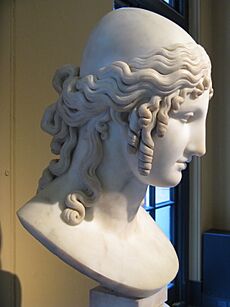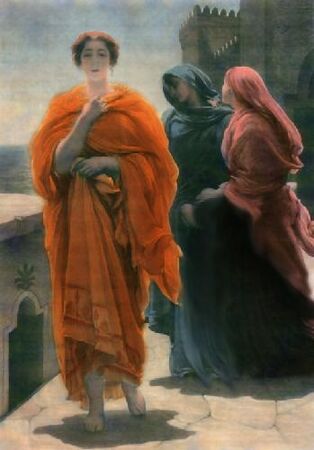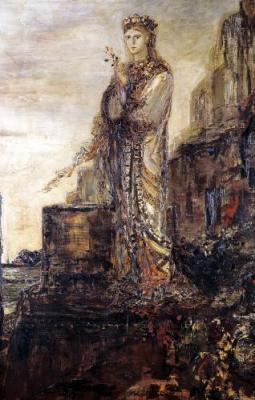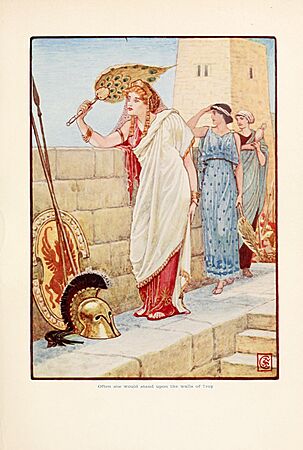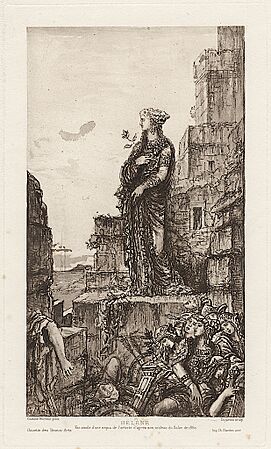Helen of Troy facts for kids
Quick facts for kids Helen |
|
|---|---|
| Queen of Sparta Princess of Troy |
|
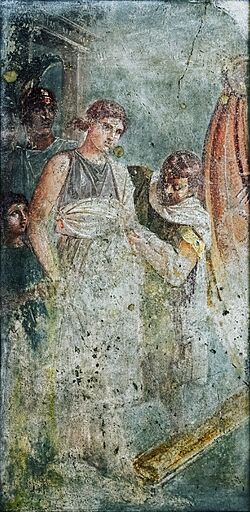
|
|
| Abode | Sparta (modern-day Sparta, Greece) Troy (modern-day Hisarlik, Turkey) |
| Personal information | |
| Born | Sparta, Greece |
| Died | Sparta, Greece |
| Consort | Menelaus Paris Deiphobus |
| Offspring |
At least 5, including Hermione
by Menelaus
by Paris
|
| Parents | |
| Siblings | Pollux (full-brother) Clytemnestra, Castor, Timandra, Phoebe, Philonoe and other children of Zeus (half-siblings) |
Helen (Ancient Greek: Ἑλένη, romanized: Helénē ), also known as Helen of Troy or Helen of Sparta, was a famous figure in Greek mythology. She was said to be the most beautiful woman in the world.
People believed she was the daughter of Zeus, the king of the gods, and either Leda or Nemesis. She had several siblings, including Clytemnestra and the twin brothers Castor and Pollux. Helen was married to King Menelaus of Sparta, and they had a daughter named Hermione. Her story is most famous because her leaving with Paris of Troy caused the great Trojan War.
Helen's story comes from ancient writers like Homer, who wrote the Iliad and the Odyssey. When she was young, she was kidnapped by Theseus. Later, many princes wanted to marry her. Menelaus won her hand. All the men who wanted to marry her had to promise to help Menelaus if Helen was ever taken from him. This promise led to the Trojan War when Paris took her away. It's not clear if she was kidnapped by Paris or if she chose to run away with him.
During the Trojan War, stories about Helen are different. Homer shows her feeling sad and wishing she hadn't left. In some tales, Helen never even went to Troy. Instead, she stayed in Egypt during the whole war. After Paris died, Helen was reunited with Menelaus in Homer's story. Other versions say she went to Mount Olympus to live with the gods. People in ancient Laconia (a region in Greece) even worshipped her.
Her amazing beauty inspired artists through history. They often showed her as the perfect example of human beauty. Pictures of Helen started appearing around the 7th century BC. In ancient Greece, her abduction by Paris was a very popular subject for art.
Contents
What Her Name Means
The meaning of Helen's name is a puzzle for experts. Some people in the 1800s thought Helen was linked to the moon (Selene).
Later, in the early 1900s, some thought her name came from a Greek word meaning "torch." Others have suggested it might be connected to the root of the word Venus.
More recently, some experts believe Helen's name might have two different meanings, linked to different myths. One idea connects her name to "the shining one," possibly a goddess related to light, like St. Elmo's fire. Another idea links her to a "vegetation goddess" worshipped in a place called Therapne, where she was known as "Helena of the Trees."
Some also connect her name to an ancient sun goddess, noting its link to the word for "sun" in different languages, including the Greek word for the sun god, Helios. This suggests Helen might have been seen as the "mistress of sunlight."
Helen in Ancient Stories
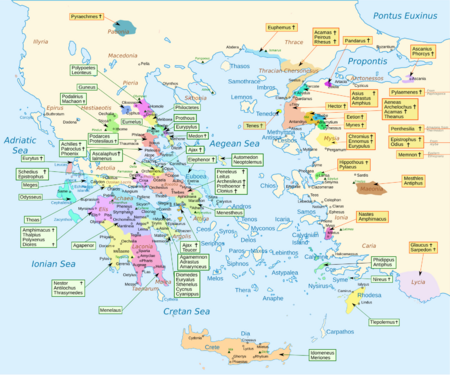
Helen first appears in the poems of Homer. She became a very popular character in Greek stories. These stories take place in the last years of the Age of Heroes. This was a time in Greek myths when heroes did amazing things. Some scholars think these stories might come from even older traditions from the Mycenaean period.
Archaeologists have found that the area of modern-day Laconia was an important place in the Late Bronze Age. Ancient poets said it was a rich kingdom. While archaeologists haven't found a huge palace under modern Sparta, findings suggest the area around Menelaion was a center of Mycenaean Laconia.
Her Family
Helen and Menelaus had a daughter named Hermione. Some stories say they also had one or more sons, like Nicostratus or Megapenthes. However, other stories say these sons were not Helen's children.
Helen and Paris had three sons, Bunomus, Aganus, and Idaeus, and a daughter also named Helen. Their three sons died during the Trojan War when an earthquake caused their house to fall.
Her Story in Myths
How Helen Was Born
Most stories, including Homer's Iliad and Odyssey, say Helen was the daughter of Zeus and Leda. Leda was the wife of King Tyndareus of Sparta. A play by Euripides from the 5th century BC tells the most common story: even though Tyndareus was her supposed father, Helen was truly Zeus's daughter.
However, another ancient poem, the Cypria, says Helen was the daughter of Zeus and the goddess Nemesis.
Kidnapped as a Young Girl
Two men from Athens, Theseus and Pirithous, believed they should marry goddesses because they were sons of gods. They decided to help each other kidnap two daughters of Zeus. Theseus chose Helen, and Pirithous wanted to marry Persephone, the wife of Hades.
Theseus took Helen and left her with his mother or a friend. Then, Theseus and Pirithous went to the underworld to kidnap Persephone. Hades tricked them, and they were trapped. Helen's brothers, Castor and Pollux, then invaded Athens to get her back. They rescued their sister and returned her to Sparta.
In most stories, Helen was very young when this happened, perhaps around seven or ten years old.
Many Suitors

When Helen was old enough to marry, many kings and princes from all over the world came to ask for her hand. They brought rich gifts. Helen's brothers, Castor and Pollux, helped manage the many suitors, but King Tyndareus made the final choice. Menelaus, who would become her husband, sent his brother Agamemnon to represent him.
The Oath of Tyndareus
Tyndareus was worried about choosing a husband for Helen. He feared that the men he didn't choose would get angry and cause trouble. Odysseus, one of the suitors, offered a solution. He promised to help Tyndareus if Tyndareus would help him marry Penelope.
Odysseus suggested that all the suitors should swear a very serious oath. They had to promise to protect Helen's chosen husband if anyone ever tried to take her away. After they all swore this oath, Menelaus was chosen to be Helen's husband. To show how important this promise was, Tyndareus sacrificed a horse.
Helen and Menelaus became the rulers of Sparta. They ruled for at least ten years and had their daughter, Hermione. Some myths say they also had sons.
This marriage marked the start of the end of the Age of Heroes. The Trojan War, caused by Helen leaving with Paris, was seen as a way for Zeus to bring an end to the age of heroes.
Helen in Egypt
At least three ancient Greek writers said that Helen never actually went to Troy. Instead, they claimed she stayed in Egypt during the Trojan War. These writers were Euripides, Stesichorus, and Herodotus.
In Euripides' play Helen, the goddess Hera created a copy of Helen out of clouds. This copy, called an eidolon, went to Troy. The real Helen was taken by Hermes to Egypt and stayed there for the entire war.
The historian Herodotus also supported the "Egyptian" version. He said he traveled to Egypt and spoke with priests. They told him that Helen arrived in Egypt after leaving Sparta because strong winds blew Paris's ship off course. The Egyptian King Proteus of Egypt was angry that Paris had fallen in love with his host's wife and stolen from his home. So, King Proteus stopped Paris from taking Helen to Troy. Paris returned to Troy without Helen.
The Greeks, however, didn't believe Helen was in Egypt. They thought she was in Troy. So, Helen waited in Memphis, Egypt, for ten years while the Greeks and Trojans fought. After the Trojan War ended, Menelaus sailed to Memphis, where King Proteus reunited him with Helen.
Helen in Troy
When Menelaus found out his wife was gone, he called on all the other suitors to keep their oaths. This started the Trojan War.
The Greek ships gathered, but they couldn't sail because there was no wind. The goddess Artemis was angry, and the only way to calm her was to sacrifice Agamemnon's daughter, Iphigenia. In Euripides' play Iphigenia in Aulis, Iphigenia's mother, Clytemnestra (Helen's sister), begged her husband not to sacrifice their daughter. She called Helen a "wicked woman."
-
Helen on the Ramparts of Troy by Frederick Leighton.
-
Gustave Moreau shows Helen with a blank or sad face.
Before the fighting began, the Greeks sent Menelaus and Odysseus to Troy. They tried to convince Priam, the king of Troy, to give Helen back, but they failed.
Homer describes Helen in Troy as sad and lonely. She felt bad about what she had caused. By the end of the war, the Trojans had come to dislike her. When Hector, a Trojan hero, died, Helen was one of the mourners. She said that only Hector and Priam had ever been kind to her in Troy. She also spoke harshly about Paris, comparing him to the brave Hector.
After Paris was killed in battle, there was a disagreement among the Trojans about which of Priam's remaining sons Helen should marry. She was eventually given to Deiphobus.
During the Fall of Troy
Helen's role during the fall of Troy is unclear. Some stories say she was sneaky and happy about the Trojans' defeat. Other stories show her as lonely and helpless, desperately trying to find safety as Troy burned.
One story says that both Greeks and Trojans wanted to stone her to death. When Menelaus finally found her, he raised his sword to kill her. But when he saw her beauty, she dropped her robe, and he was so stunned that he let his sword fall.
What Happened to Her
Helen returned to Sparta and lived with Menelaus. In Homer's The Odyssey, they were happy together. Menelaus held no anger about her leaving, and Helen freely shared stories about her life inside Troy during the war.
Another version says that Apollo saved Helen from Orestes and took her to Mount Olympus to live as a goddess. A different story says Helen shared the afterlife with the hero Achilles.
In Euripides' play The Trojan Women, Helen is hated by the women who survived the war. She is taken back to Greece to face a death sentence. However, this contradicts other plays by Euripides, where Helen is in Egypt during the Trojan War.
How Artists Showed Helen
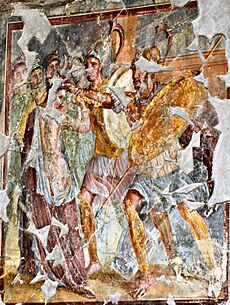
From ancient times, showing Helen's beauty was a big challenge for artists. The story of Zeuxis tells how he tried to create the perfect image of beauty. He chose the best features from five different young women.
Ancient artists started painting Helen or carving her image on stone, clay, and bronze around the 7th century BC. One ancient writer described Helen as "beautiful, innocent, and charming. Her legs were the best; her mouth the cutest. There was a beauty-mark between her eyebrows."
On ancient Athenian vases, Helen is often shown being threatened by Menelaus and trying to run away from him. However, in art from Laconia (Sparta's region), it's different. On one ancient stone carving, Menelaus has a sword, but Helen bravely faces him, looking directly into his eyes. In other art from that area, Helen holds a wreath, while Menelaus holds his sword straight up.
The story of Paris taking Helen was also very popular in ancient Greek vase-painting. More popular than her earlier kidnapping by Theseus. In a famous painting by Makron, Helen follows Paris like a bride, with Paris holding her wrist. The Etruscans, who knew a lot about Greek myths, were especially interested in the story of Helen's birth from an egg.
In Renaissance paintings, Helen leaving Sparta is often shown as Paris forcing her to go. But in some medieval pictures, Paris and Helen are shown leaving arm in arm, as if they chose to go together.
In Christopher Marlowe's play Doctor Faustus (1604), the character Faustus uses magic to bring back Helen's spirit. When he sees her, he says the famous line: "Was this the face that launch'd a thousand ships, / And burnt the topless towers of Ilium." This means her beauty caused a thousand ships to sail to war and burned the high towers of Troy. Helen also appears in Goethe's Faust.
In William Shakespeare's play Troilus and Cressida, Helen is a small character who loves Troilus.
In Pre-Raphaelite art, Helen is often shown with shiny, curly hair. Other painters from that time show Helen on the walls of Troy, with a blank or sad expression. In Gustave Moreau's painting, Helen's face even disappears, becoming a blank image among Troy's ruins.
Her Worship
Helen was mainly worshipped in Laconia, the region of Sparta. In Sparta itself, there was a special place for Helen near some plane trees. Ancient stories say Helen was linked to athletic exercises and dances performed by young women near the Evrotas River. A poet named Theocritus wrote about a song Spartan women sang at this place, celebrating Helen's marriage to Menelaus. They would carve words into a tree bark saying, "Reverence me. I am Helen's tree."
Helen was also worshipped on the other side of the Eurotas River, at a place called Therapne. Here, she shared a shrine with Menelaus and the Dioscuri (her brothers). This shrine was known as the Menelaion. People believed Helen was buried there with Menelaus. Even though it's called Menelaion, the shrine and its worship originally belonged to Helen. Menelaus was added later as her husband. There was also a festival in their honor called Meneleaeia.
Some ancient writers said that Helen and Menelaus were worshipped as gods at Therapne, not just heroes. If Helen was worshipped as a goddess, her powers might have been related to fertility or to the sun. There is also proof of Helen's worship in later Spartan times, with rules for sacrifices and feasts held in their honor.
Helen was also worshipped in Attica (the region of Athens) with her brothers. On the island of Rhodes, she was worshipped as Helen Dendritis, which means "Helen of the Trees." This suggests she was seen as a goddess of plants or fertility. Some experts believe her worship in Rhodes goes back to the Minoan period, before the Greeks, when she might have been worshipped as a vegetation goddess.
See also
 In Spanish: Helena (mitología) para niños
In Spanish: Helena (mitología) para niños
- Astyanassa
- Simon Magus and Helen


